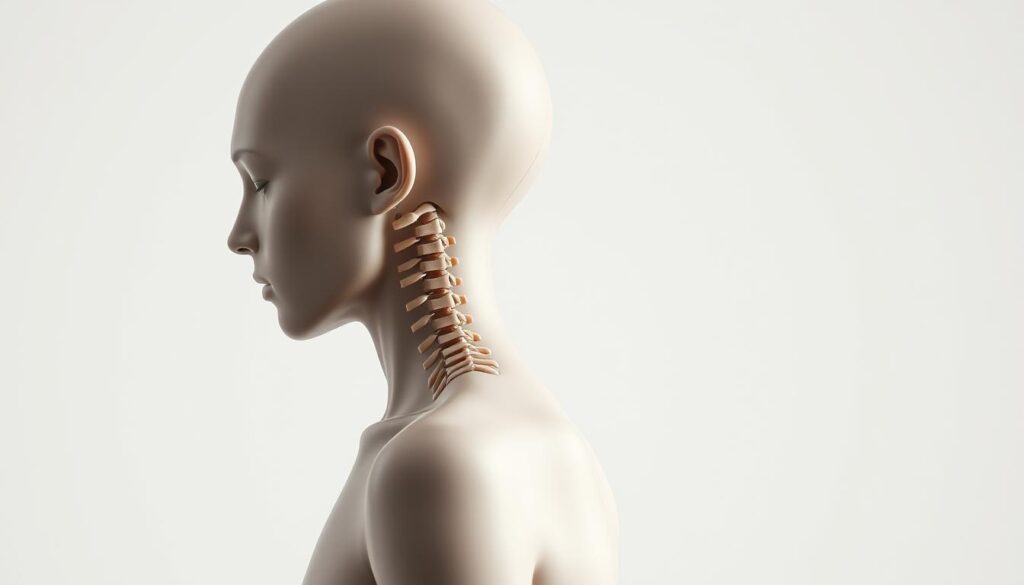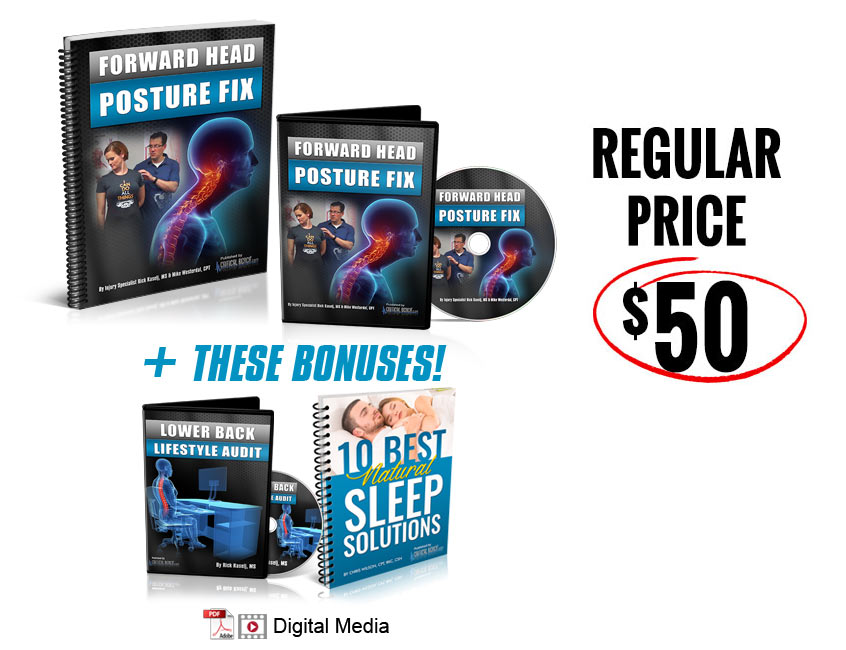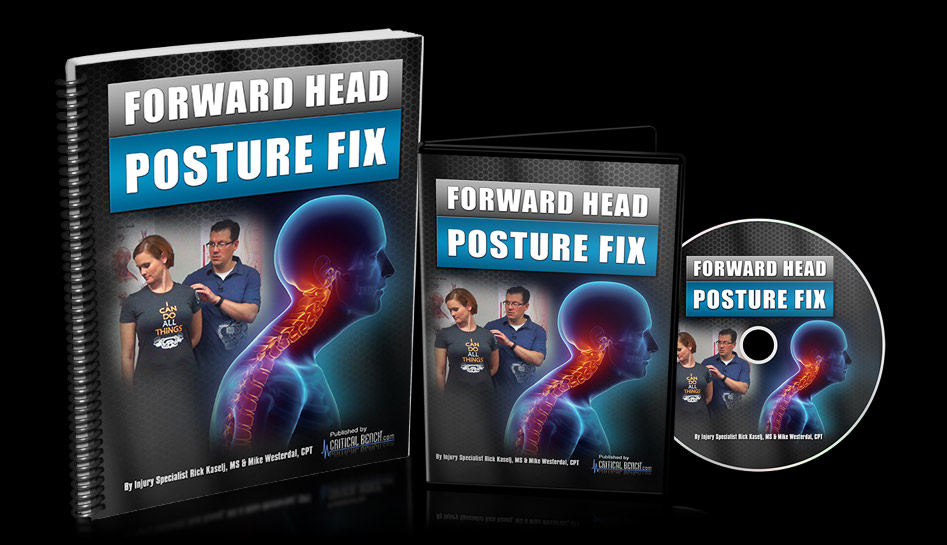In this guide, we’ll show you how to fix forward head posture, also known as “nerd neck” or “text neck.” We’ll cover the main causes and offer practical solutions. You’ll learn how to improve your posture, reduce neck pain, and enhance your overall health.
Whether you work in an office, are a student, or use digital devices a lot, these tips will help. They’ll help you regain control of your posture and boost your confidence.
Forward Head Posture Fix: Improve Your Posture Now
Correct your posture and relieve neck pain with simple, effective exercises.
Regain confidence and align your spine for a healthier, pain-free life!
Key Takeaways
- Understand the causes and consequences of forward head posture
- Discover effective exercises and stretches to correct posture
- Learn about ergonomic workspace setup to support good posture
- Develop posture awareness and build healthy habits
- Find relief for neck pain and rounded shoulders
Understanding Forward Head Posture
Forward head posture is when your head is too far forward of your shoulders. This can cause neck pain, headaches, and even spinal problems over time.
What is Forward Head Posture?
It’s a condition where your head tilts forward, upsetting the spine and neck’s balance. It often comes from sitting too long, too much screen time, or bad work setups.
Causes and Consequences
The main reasons for forward head posture are:
- Sitting or standing for too long in a hunched way
- Using smartphones, tablets, and computers too much
- Bad ergonomics at work
- Weak muscles in the head and neck area
The effects of forward head posture can be serious, including:
- Neck pain and stiffness
- Headaches and migraines
- Shoulder and upper back pain
- Less movement in the neck
- Long-term spinal problems like disc degeneration and herniation
It’s important to fix forward head posture to keep your health good and avoid these problems.

“Fixing forward head posture is essential for reducing neck pain, headaches, and other musculoskeletal issues.”
Forward Head Posture Fix
Fixing forward head posture needs a mix of exercises, lifestyle changes, and ergonomic tweaks. By tackling the root causes and following a detailed plan, you can fix this common posture issue. This will boost your overall health and well-being.
Stretching tight chest, shoulder, and neck muscles is crucial. Also, strengthening your upper back and core is important. Regularly practicing posture correction techniques helps align your spine. It also relieves neck strain.
Adjusting your workspace is also key in correcting forward head posture. Make sure your computer screen is at eye level. Use a supportive chair and take breaks to stretch. These steps help reduce sitting strain and neck pain.
By combining these strategies, you can slowly improve your posture. This will reduce pain and enhance your health and well-being.

“Proper posture is not just about looking good – it’s about feeling good and reducing the risk of long-term health issues.”
Improving your posture is a journey. It may take time and effort to see lasting changes. Stay patient, persistent, and committed. With dedication, you can achieve the posture correction techniques needed for a healthier, more confident life.
Exercises to Correct Posture
Fixing forward head posture needs a mix of actions. Adding posture correction exercises is key. These exercises align your spine and shoulders. They also strengthen muscles for good posture.
Stretches for Tight Muscles
Tight muscles in the neck, shoulders, and upper back cause forward head posture. Neck stretches can help loosen these muscles. Try neck rolls, shoulder rolls, and chest openers to improve alignment.
Strengthening Exercises
Stretching is just part of the solution. Upper back strengthening exercises are also vital. They help pull your shoulders back and align your spine. Try seated rows, shoulder blade squeezes, and reverse fly movements.
| Posture Correction Exercises | Benefits |
|---|---|
| Neck Stretches | Improve neck mobility and reduce tension |
| Upper Back Strengthening | Enhance shoulder posture and spinal alignment |
| Posture Awareness Exercises | Develop mindfulness and correct poor postural habits |
Doing a mix of these posture correction exercises daily can help fix your posture. It may take time to change your body’s habits. Be patient and keep practicing to get better.
Ergonomic Workspace Setup
Setting up your workspace ergonomically is key for good office posture and avoiding text neck prevention. By adjusting your desk, chair, and computer, you can lower the chance of getting a forward head posture. This also helps prevent musculoskeletal problems.
To make your ergonomic desk setup better, follow these tips:
- Make sure your chair height is right so your thighs are parallel to the ground. Your feet should be flat on the floor or on a footrest.
- Put your computer monitor at eye level, about an arm’s length away. This helps avoid neck strain.
- Use a document holder next to your monitor. It keeps reading materials at the same level as your screen. This reduces the need to look down often.
- Get a supportive, adjustable office chair that helps your lower back and lumbar area.
- Think about using a standing or adjustable-height desk. It encourages you to stand and move more during the day.
| Ergonomic Desk Setup Recommendation | Benefit |
|---|---|
| Monitor at eye level | Reduces neck strain and forward head posture |
| Supportive, adjustable chair | Promotes proper spine alignment and reduces lower back pain |
| Standing or adjustable-height desk | Encourages movement and breaks from prolonged sitting |
By using these ergonomic desk setup tips, you can make a workspace that supports good office posture. It also helps prevent text neck prevention.
Posture Awareness and Habit Formation
Good posture is more than just exercises. It’s about knowing how your body is aligned and building lasting habits. We’ll look at mindfulness techniques to help you stay aware of your posture awareness all day. This makes it simpler to create and keep up healthy habit formation to avoid forward head posture.
Mindfulness Techniques
Mindfulness is a great way to boost your posture awareness and build lasting habit formation. By focusing on the present and your body’s alignment, you can spot and fix bad posture habits early on.
- Set reminders to check in with your posture throughout the day.
- Practice deep breathing exercises to stay grounded and centered.
- Visualize your spine aligning from the base to the top of your head.
- Engage in mindfulness for posture exercises, such as body scans or mindful movement.
Adding these mindfulness techniques to your daily life can make you more aware of your body’s position and movements. This helps you keep good posture awareness and build healthy habit formation for better posture over time.
“The secret of change is to focus all of your energy, not on fighting the old, but on building the new.” – Socrates
Neck Pain Relief for Text Neck

Forward Head Posture Fix: Realign and Revitalize Your Posture
Unlock the secrets to better posture and eliminate neck strain for good.
Stand tall, boost your confidence, and improve overall well-being today!
If you’re feeling neck pain from looking down too much, there are ways to help. Gentle stretches, massage, and special neck exercises can ease your discomfort. We’ll show you how to feel better.
Alleviating Neck Pain with Stretches
Stretching is a simple yet effective way to ease neck pain. Try these easy exercises:
- Neck tilts: Slowly tilt your head to each side, holding the stretch for 30 seconds.
- Shoulder rolls: Roll your shoulders up, back, and down in a circular motion to release tension.
- Chin tucks: Gently pull your chin back, creating a double chin, to stretch the front of your neck.
Massage for Text Neck Relief
Massage is also great for neck pain and text neck treatment. It helps relax the muscles at the base of your skull and along your neck.
“Regular massage can help improve cervical alignment and reduce the symptoms of forward head posture.”
By adding these methods to your daily routine, you can ease text neck pain. This helps improve your posture and reduces neck pain.
Rounded Shoulders Fix
Good shoulder posture is key for a healthy body. Rounded shoulders can lead to neck pain and back issues. Luckily, there are exercises and stretches to fix this and improve your posture.
Exercises for Improved Shoulder Posture
To tackle rounded shoulders, strengthen your upper back and stretch your chest and shoulders. Here are some exercises to try:
- Shoulder Rolls: Roll your shoulders back and down in circles. This will engage your muscles.
- Chest Opener Stretch: Stand in a doorway, place your forearms on the frame, and lean forward to stretch your chest.
- Seated Row: Sit upright and use resistance bands or dumbbells for seated rows. Squeeze your shoulder blades together.
- Wall Angels: Stand with your back against a wall, arms raised overhead. Slide your arms down the wall, keeping your back and elbows in contact.
Adding these shoulder posture exercises to your routine can boost your upper back strength. This will help you stand up straighter and more balanced.
“Proper shoulder posture is essential for overall body alignment and preventing issues like neck pain and back discomfort.”
Cervical Alignment Techniques
Keeping the cervical alignment right is key to fixing forward head posture. It helps ease neck pain and discomfort. There are many ways to fix the spine’s natural curve and ease text neck symptoms.
Gentle Mobilization Exercises
Doing gentle mobilization exercises is a good start. These exercises slowly move the neck, improving flexibility and easing stiffness. Examples include:
- Slow neck rotations
- Gentle neck tilts
- Chin tucks
Manual Therapy
Manual therapy is also helpful for cervical alignment. Physical therapists or chiropractors use techniques like:
- Spinal manipulation
- Soft tissue massage
- Myofascial release
These methods help joints work right and muscles relax. This leads to less neck pain and better posture.
Specialized Treatments
For serious cases of forward head posture or text neck, special treatments are needed. These include:
| Treatment | Description |
|---|---|
| Kinesio Taping | Special tape is used to support and align the neck and upper back. |
| Postural Restoration Therapy | This therapy fixes muscle imbalances and movement patterns that cause poor posture. |
| Cervical Traction | Gentle traction is applied to the neck to separate vertebrae and reduce compression. |
Using a mix of these cervical alignment methods can help. It aims to restore the spine’s natural curve, reduce neck pain, and ease text neck symptoms.
Desk Worker Stretches
Desk workers often find it hard to keep good posture while working on computers. Simple stretches can help a lot. They can ease the strain on your neck and shoulders. This improves your office posture and stops text neck.
Office-Friendly Routines
Finding easy stretches for your workday is key. Here are some routines you can try:
- Neck Rolls: Roll your head in circles to loosen your neck.
- Shoulder Shrugs: Lift your shoulders up, hold, then release to ease upper back tightness.
- Desk Push-Ups: Place hands on the desk, lower your chest, then push back up to work your core and chest.
- Wrist Stretches: Hold your arms out, palms down, and pull your fingers towards you to stretch your wrists and forearms.
These desk worker stretches can be done quietly all day. They help keep your office posture good and stop text neck without interrupting your work.
“Taking regular breaks to stretch and move can make a world of difference in how you feel throughout the workday.”
| Stretch | Benefits | Duration |
|---|---|---|
| Neck Rolls | Releases tension in the neck | 30 seconds |
| Shoulder Shrugs | Alleviates tightness in the upper back and shoulders | 20 seconds |
| Desk Push-Ups | Engages the core and chest muscles | 10 reps |
| Wrist Stretches | Targets the wrists and forearms | 30 seconds per arm |
Adding these desk worker stretches to your daily routine helps a lot. It keeps your office posture good and stops text neck. Listen to your body and adjust as needed to find what works best for you.
Upper Back Strengthening
Keeping your posture right is key for a healthy spine. Strengthening your upper back is vital for this. Exercises targeting this area can fix forward head posture and rounded shoulders.
We’ll look at exercises that strengthen the upper back. These help correct posture and improve alignment. They also stabilize the shoulders, which is important for those who sit a lot or use devices for hours.
Strengthening Exercises for the Upper Back
- Seated Row: Sit straight with your back against a wall, holding a resistance band or light dumbbell. Pull the band or weight back, squeezing your shoulder blades together.
- Reverse Fly: Stand with your feet apart, bend forward at the hips, and lift your arms out to the sides. Squeeze your shoulder blades together at the top.
- Superman: Lie face-down on the floor, extend your arms and legs, and lift your arms, chest, and legs off the ground. This engages your upper back muscles.
| Exercise | Target Muscles | Benefits |
|---|---|---|
| Seated Row | Rhomboids, Trapezius | Strengthens the upper back and improves shoulder stability |
| Reverse Fly | Posterior Deltoids, Trapezius | Targets the upper back and helps correct rounded shoulders |
| Superman | Erector Spinae, Trapezius | Engages the entire upper back and improves spinal alignment |
Adding these exercises to your routine can ease neck and shoulder strain. This leads to better posture and less discomfort.
Nerd Neck Solution
Ah, the infamous “nerd neck” – a common condition for those hunched over digital devices. But don’t worry, tech lovers! We have a solution to fix your posture and get rid of “nerd neck” for good.
To beat this modern problem, mix the techniques we’ve talked about. By fixing forward head posture and using a whole-body approach, you can say no to “text neck” and “nerd neck” discomfort.
- Begin with exercises to correct your posture. Focus on the tight muscles causing your rounded shoulders and tilted head. Stretching and strengthening can realign your cervical spine.
- Make your workspace ergonomic to ease neck and upper back strain. Adjust your desk, chair, and monitor to keep your eyes level with the screen.
- Use mindfulness to stay aware of your posture. Check your body often and adjust to keep your alignment right.
- Try neck pain relief methods for any discomfort from “nerd neck.” Options like massage and heat therapy can help right away.
Remember, improving your posture is a journey. With regular effort and self-care, you can say goodbye to “nerd neck.” Let’s start your journey to better posture!
“Posture is not just about how you look, it’s about how you feel and perform.” – Dr. Eric Goodman, Founder of Foundation Training
Conclusion
Fixing forward head posture is key to better health. By using the tips from this guide, you can ease neck pain and improve your posture. This will also boost your confidence.
Stick to the posture-correcting methods in this article for lasting benefits. Enjoy a healthier body with better alignment. The exercises and ergonomic tips here help you manage forward head posture fix, posture improvement, and neck pain relief.
Start your posture improvement journey with dedication. Make these habits part of your daily life. See how they positively affect your health and mind. Focus on forward head posture fix, posture improvement, and neck pain relief to unlock your body’s full potential.
Fix Forward Head Posture: Enhance Your Posture Today
Say goodbye to slouching and neck pain with easy, targeted solutions.
Improve your posture and feel the difference in your daily life instantly!
FAQ
What is forward head posture?
Forward head posture, also known as “nerd neck” or “text neck,” is when your head is in front of your shoulders. It can cause neck pain, headaches, and even long-term spinal problems.
What are the causes of forward head posture?
Prolonged sitting, too much screen time, poor ergonomics, and weak upper back muscles are the main causes. These factors pull your head forward, straining your neck and muscles.
How can I fix my forward head posture?
Fixing forward head posture needs a mix of exercises, lifestyle changes, and ergonomic adjustments. Doing stretches for tight muscles, strengthening the upper back, and setting up your desk right can help.
What are some effective exercises for correcting forward head posture?
Exercises like neck stretches, shoulder rolls, chin tucks, and upper back strengthening can help. These movements ease muscle tightness, improve spinal alignment, and support good posture.
How can I set up an ergonomic workspace to prevent forward head posture?
Make sure your computer screen is at eye level, your chair supports your back, and your desk is at the right height. Standing desks or regular breaks can also help prevent forward head posture.
How can I maintain good posture and develop sustainable habits?
Good posture habits need mindfulness and consistent practice. Regular posture checks, reminders, and mindfulness exercises can keep you aware of your posture. Being consistent is key to making good posture a habit.
How can I relieve neck pain associated with forward head posture?
Try gentle neck stretches, massage, and cervical alignment techniques to relieve neck pain. A physical therapist or chiropractor can also provide relief and address the causes of your neck discomfort.
What exercises can help fix rounded shoulders?
Exercises targeting the upper back and shoulder muscles can fix rounded shoulders. Examples include row variations, shoulder blade squeezes, and resistance band exercises to strengthen the upper back and improve shoulder positioning.
How can I incorporate desk worker stretches into my daily routine?
You can easily add desk worker stretches to your day, like shoulder rolls, neck tilts, and standing back extensions. These exercises can be done throughout the day to counteract sitting and forward head posture.
What is the “nerd neck” solution?
The “nerd neck” solution involves a comprehensive approach. This includes targeted exercises, ergonomic adjustments, and postural awareness. By combining these, you can effectively correct “nerd neck” and regain a healthy posture.

